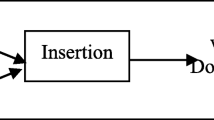Abstract
This paper proposes a blind audio watermarking algorithm to embed data and extract them by changing the Discrete Cosine Transform (DCT) coefficients. The key idea is to divide the selected frequency band of DCT into short frames and change the samples of each frame based on the watermark bits that are embedded in. The proposed idea uses linear regression and standard deviation to extract watermark bits. The experimental results show that the method has a high capacity about 3000 bps data payload, without significant perceptual distortion. Moreover, this idea provides robustness against common signal processing attacks such as Additive White Gaussian Noise, Resampling, Re-quantizing and Echo.






Similar content being viewed by others
References
Al-Haj A (2014) A dual transform audio watermarking algorithm. Multimedia Tools Appl 73(3):1897–1912
Al-Haj A (2014) An imperceptible and robust audio watermarking algorithm. EURASIP J Audio Speech, and Music Process 37(1):1–12
Bhat V, Sengupta I, Das A (2010) An adaptive audio watermarking based on the singular value decomposition in the wavelet domain. Digital Signal Process 20 (6):1547–1558
Bhat V, Sengupta I, Das A (2011) An audio watermarking scheme using singular value decomposition and dither-modulation quantization. Multimedia Tools Appl 52 (2-3):369–383
Charfeddine M, Elarbi M Amar CB (2014) A new DCT audio watermarking scheme based on preliminary MP3 study. Multimedia Tools Appl 70(3):1521–1557
Cox IJ, Kilian J, Leighton FT, Shamoon T (1997) Secure spread spectrum watermarking for multimedia. IEEE Trans Image Process 6(12):1673–1687
Cvejic N (2004) Spread spectrum audio watermarking using frequency hopping and attack characterizationl. Signal Process 84(1):207–213
Fallahpour M, Megas D (2009) High capacity audio watermarking using FFT amplitude interpolation. IEICE Electron Express 6(14):1057–1063
Fallahpour M, Megas D (2011) High capacity audio watermarking using the high frequency band of the wavelet domain. Multimedia Tools Appl 52(2-3):485–498
Freedman DA (2009) Statistical models: theory and practice. cambridge university press
Jain P, Trivedi VK, LNCT B (2012) A Novel Technique for Data Hiding in Audio by Using DWTS. Int J Computational Eng Manag 15(4):2230–7893
Johnson NF, Duric Z, Jajodia S (2001) Information Hiding: Steganography and Watermarking-Attacks and Countermeasures. J. Electron Imaging 10(3):825–826
Kang X, Yang R, Huang J (2011) Geometric invariant audio watermarking based on an LCM feature. IEEE Trans Multimedia 13(2):181–190
Ko B-S, Nishimura R, Suzuki Y (2005) Time-spread echo method for digital audio watermarking. IEEE Trans Multimedia 7(2):212–221
Malik H, Ansari R, Khokhar A (2008) Robust audio watermarking using frequency-selective spread spectrum. IET Inf Secur 2(4):129–150
Neubauer C, Herre J Audio watermarking of MPEG-2 AAC bit streams. In: Audio Engineering Society Convention 108, 2000. Audio Engineering Society
Petitcolas FA, Andersons RJ, Kuhn MG (1999) Information hiding-a survey. Proc IEEE 87(7):1062–1078
Thiede T, Treurniet WC, Bitto R, Schmidmer C, Sporer T, Beerends JG, Colomes C (2000) PEAQ-The ITU standard for objective measurement of perceived audio quality. J Audio Eng Soc 48(1/2):3– 29
Trivedi NK Trivedi MC An Algorithmic Digital Audio Watermarking in Perceptual Domain Using Direct Sequence Spread Spectrum. In: 2014 Fourth International Conference on Communication Systems and Network Technologies (CSNT), 2014. IEEE, pp 805–809
Zhang Z (2012) Frontier and Methodologies on Digital Rights Management for Multimedia Social Networks. Int J Digit Content Technol Appl 6(9)
Zhang Z, Wang Z, Niu D (2015) A novel approach to rights sharing-enabling digital rights management for mobile multimedia. Multi Tools Appl 74(16):6255–6271
Author information
Authors and Affiliations
Corresponding author
Rights and permissions
About this article
Cite this article
Jeyhoon, M., Asgari, M., Ehsan, L. et al. Blind audio watermarking algorithm based on DCT, linear regression and standard deviation. Multimed Tools Appl 76, 3343–3359 (2017). https://doi.org/10.1007/s11042-016-3934-9
Received:
Revised:
Accepted:
Published:
Issue Date:
DOI: https://doi.org/10.1007/s11042-016-3934-9




